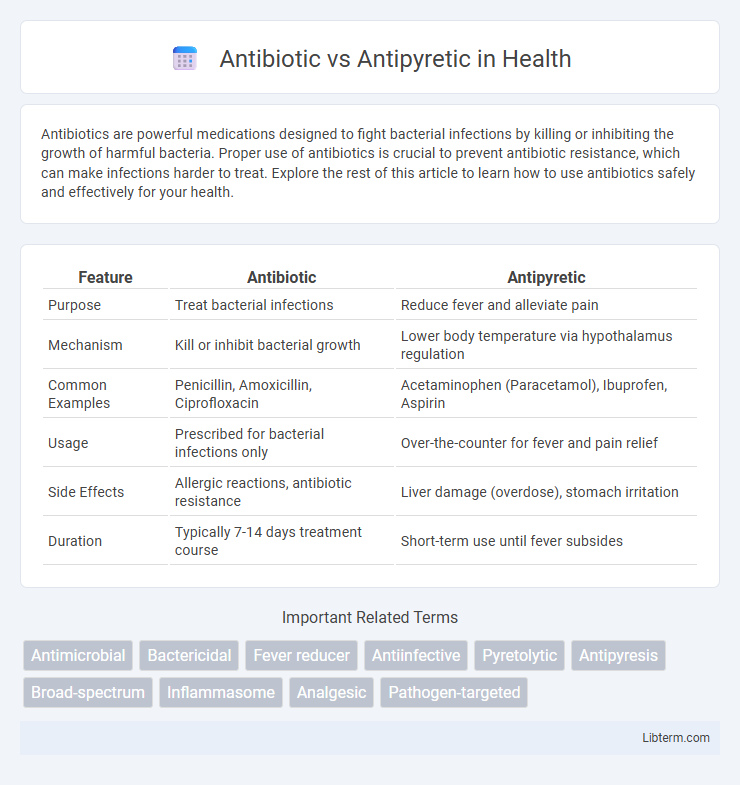Antibiotics are powerful medications designed to fight bacterial infections by killing or inhibiting the growth of harmful bacteria. Proper use of antibiotics is crucial to prevent antibiotic resistance, which can make infections harder to treat. Explore the rest of this article to learn how to use antibiotics safely and effectively for your health.
Table of Comparison
| Feature | Antibiotic | Antipyretic |
|---|---|---|
| Purpose | Treat bacterial infections | Reduce fever and alleviate pain |
| Mechanism | Kill or inhibit bacterial growth | Lower body temperature via hypothalamus regulation |
| Common Examples | Penicillin, Amoxicillin, Ciprofloxacin | Acetaminophen (Paracetamol), Ibuprofen, Aspirin |
| Usage | Prescribed for bacterial infections only | Over-the-counter for fever and pain relief |
| Side Effects | Allergic reactions, antibiotic resistance | Liver damage (overdose), stomach irritation |
| Duration | Typically 7-14 days treatment course | Short-term use until fever subsides |
Understanding Antibiotics and Antipyretics
Antibiotics are medications designed to treat bacterial infections by killing or inhibiting the growth of bacteria, making them essential in combating diseases like strep throat, urinary tract infections, and pneumonia. Antipyretics are drugs used to reduce fever by acting on the hypothalamus to lower body temperature, commonly including acetaminophen and ibuprofen. Understanding the distinct mechanisms and appropriate uses of antibiotics versus antipyretics helps prevent antibiotic resistance and ensures effective management of symptoms such as fever.
Mechanism of Action: How Antibiotics Work
Antibiotics target bacterial infections by disrupting vital processes such as cell wall synthesis, protein production, or DNA replication, leading to bacterial death or growth inhibition. Common classes include beta-lactams, which inhibit cell wall formation, and tetracyclines, which interfere with protein synthesis. This specific targeting distinguishes antibiotics from antipyretics, which primarily reduce fever by acting on the hypothalamic temperature regulation center without affecting bacterial viability.
Mechanism of Action: How Antipyretics Work
Antipyretics reduce fever by inhibiting the cyclooxygenase (COX) enzymes, leading to decreased prostaglandin E2 (PGE2) production in the hypothalamus, which lowers the body's thermal set point. Common antipyretics like acetaminophen and nonsteroidal anti-inflammatory drugs (NSAIDs) target COX-2 to prevent PGE2 synthesis, thereby controlling fever. This mechanism differentiates antipyretics from antibiotics, which act by targeting bacterial structures or functions rather than modulating immune or inflammatory pathways.
Key Differences Between Antibiotics and Antipyretics
Antibiotics are medications designed to target and eliminate bacterial infections by inhibiting bacterial growth or killing bacteria, whereas antipyretics are drugs used to reduce fever and alleviate associated symptoms without targeting the underlying cause. Antibiotics require prescription and proper diagnosis for effective use, while antipyretics like acetaminophen or ibuprofen are commonly available over-the-counter for symptomatic relief. The mechanisms of action differ significantly: antibiotics disrupt bacterial cell processes, while antipyretics act on the hypothalamus to regulate body temperature.
Common Types and Examples of Antibiotics
Common types of antibiotics include penicillins like amoxicillin, macrolides such as azithromycin, and cephalosporins including cefalexin, each targeting bacterial infections to inhibit growth or kill bacteria. Antipyretics like acetaminophen and ibuprofen function to reduce fever and alleviate pain rather than treat infection. Understanding the distinction between antibiotics for bacterial treatment and antipyretics for symptom relief is crucial for effective medical management.
Common Types and Examples of Antipyretics
Common types of antipyretics include acetaminophen (paracetamol), ibuprofen, and aspirin, which effectively reduce fever by acting on the hypothalamic heat-regulating center. These medications are widely used to alleviate fever symptoms caused by infections or inflammatory conditions without targeting the underlying bacterial cause. Unlike antibiotics such as amoxicillin or azithromycin, which treat bacterial infections, antipyretics focus solely on symptom relief rather than eliminating pathogens.
Medical Conditions Treated by Antibiotics
Antibiotics are primarily used to treat bacterial infections such as pneumonia, urinary tract infections, and strep throat by targeting and killing or inhibiting the growth of bacteria. Unlike antipyretics, which reduce fever by acting on the hypothalamus to lower body temperature, antibiotics address the underlying cause of infections. Proper usage of antibiotics is critical in managing bacterial illnesses and preventing antibiotic resistance.
Medical Conditions Treated by Antipyretics
Antipyretics are primarily used to reduce fever associated with infections such as influenza, common cold, and other viral or bacterial illnesses. Unlike antibiotics, which target bacterial infections directly, antipyretics alleviate symptoms by lowering elevated body temperature, providing relief in conditions like malaria, dengue fever, and childhood febrile seizures. These medications include acetaminophen, ibuprofen, and aspirin, which help manage fever without addressing the underlying cause.
Safety, Side Effects, and Precautions
Antibiotics target bacterial infections but carry risks such as allergic reactions, antibiotic resistance, and gastrointestinal disturbances, necessitating precise medical guidance to prevent misuse. Antipyretics like acetaminophen and ibuprofen effectively reduce fever and pain but require cautious dosing to avoid liver toxicity or gastrointestinal issues, especially in children and those with preexisting conditions. Both drug classes mandate adherence to prescribed dosages and awareness of contraindications to ensure safety and minimize adverse effects.
Choosing the Right Medication: Antibiotic or Antipyretic?
Antibiotics target bacterial infections by eliminating or inhibiting bacterial growth, making them essential for treating conditions like strep throat or urinary tract infections, while antipyretics reduce fever and alleviate discomfort caused by illnesses without addressing the underlying infection. Choosing the right medication depends on the diagnosis: antibiotics are prescribed only for bacterial infections, whereas antipyretics such as acetaminophen or ibuprofen help manage symptoms like high fever and pain regardless of infection type. Misuse of antibiotics for viral infections or solely fever reduction increases antibiotic resistance and delays appropriate care, highlighting the importance of accurate medical evaluation.
Antibiotic Infographic

 libterm.com
libterm.com